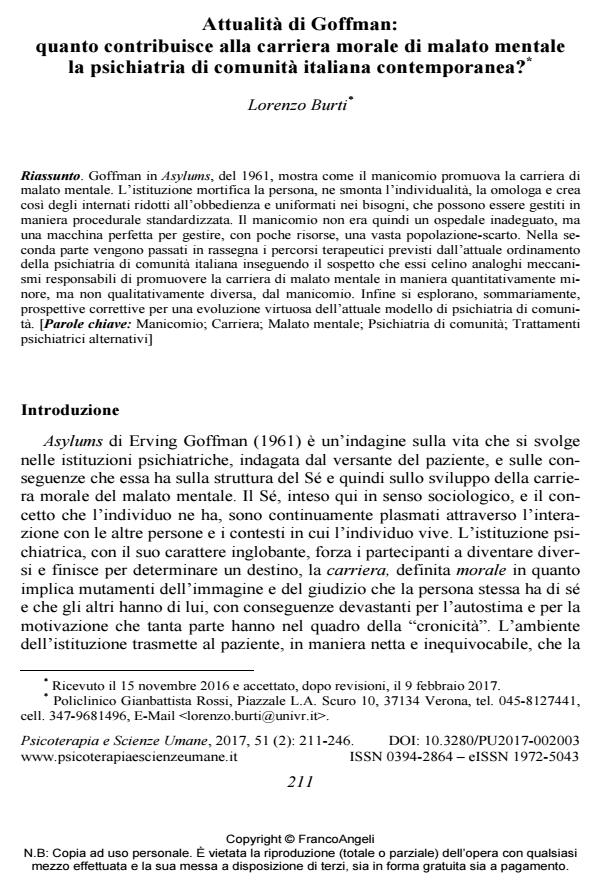Attualità di Goffman: quanto contribuisce alla carriera morale di malato mentale la psichiatria di comunità italiana contemporanea?
Journal title PSICOTERAPIA E SCIENZE UMANE
Author/s Lorenzo Burti
Publishing Year 2017 Issue 2017/2
Language Italian Pages 36 P. 211-246 File size 324 KB
DOI 10.3280/PU2017-002003
DOI is like a bar code for intellectual property: to have more infomation
click here
Below, you can see the article first page
If you want to buy this article in PDF format, you can do it, following the instructions to buy download credits

FrancoAngeli is member of Publishers International Linking Association, Inc (PILA), a not-for-profit association which run the CrossRef service enabling links to and from online scholarly content.
Erving Goffman revisited: How extensive is the contribution of today’s commu-nity mental health services in Italy to the moral career of the mental patient? In his 1961 book Asylums, Erving Goffman describes how the mental hospital promotes the career of the mental patient. Upon admission to the institution, the person is systematically, albeit often un-intentionally, mortified through a series of abasements, degradations and profanations of the self and is stripped of his individuality. In this way, the institution creates a population of inmates, reduced to obedience and standardized in their needs, that can be managed in large number in a reduced space and with few resources. This paper then investigates whether the present organization of Italian community-based psychiatric services presents similar detrimental effects and suggests possible scenarios for further developments of our model of community mental health.
Keywords: Asylums; Career; Mental patient; Community psychiatry; Alternative treatments
- La necessità del cambiamento Andrea Angelozzi, in PSICOTERAPIA E SCIENZE UMANE 4/2022 pp.545
DOI: 10.3280/PU2022-004002 - Diario della psicoterapia di Federico (1955-56) Berta Neumann, Eugenia Omodei Zorini, in PSICOTERAPIA E SCIENZE UMANE 3/2019 pp.417
DOI: 10.3280/PU2019-003003 - Dibattiti - La fine di un'illusione Andrea Angelozzi, in PSICOTERAPIA E SCIENZE UMANE 4/2017 pp.609
DOI: 10.3280/PU2017-004010 - Dibattiti. Alcuni chiarimenti a proposito di pericolosità e controllo in psichiatria Paolo Francesco Peloso, in PSICOTERAPIA E SCIENZE UMANE 3/2017 pp.447
DOI: 10.3280/PU2017-003008 - Dieci problemi per una reale riforma della salute mentale Andrea Angelozzi, in PSICOTERAPIA E SCIENZE UMANE 3/2019 pp.481
DOI: 10.3280/PU2019-003006 - Editoriale Giuseppe Saraò, Giacomo Tessari, in INTERAZIONI 1/2018 pp.7
DOI: 10.3280/INT2018-001001 - Interventi Euro Pozzi, in PSICOTERAPIA E SCIENZE UMANE 2/2017 pp.303
DOI: 10.3280/PU2017-002008 - When psychotherapy encounters chronicity: Challenges and possible remedies Lorenzo Burti, in RIVISTA SPERIMENTALE DI FRENIATRIA 3/2018 pp.97
DOI: 10.3280/RSF2018-003006
Lorenzo Burti, Attualità di Goffman: quanto contribuisce alla carriera morale di malato mentale la psichiatria di comunità italiana contemporanea? in "PSICOTERAPIA E SCIENZE UMANE" 2/2017, pp 211-246, DOI: 10.3280/PU2017-002003